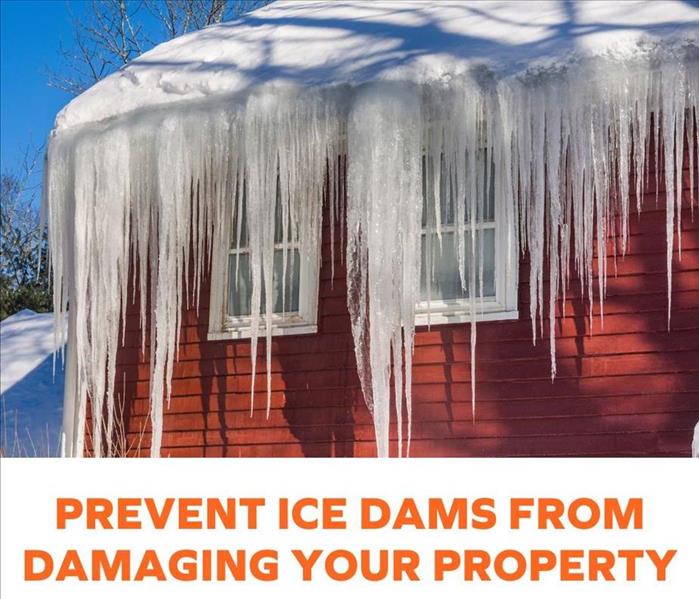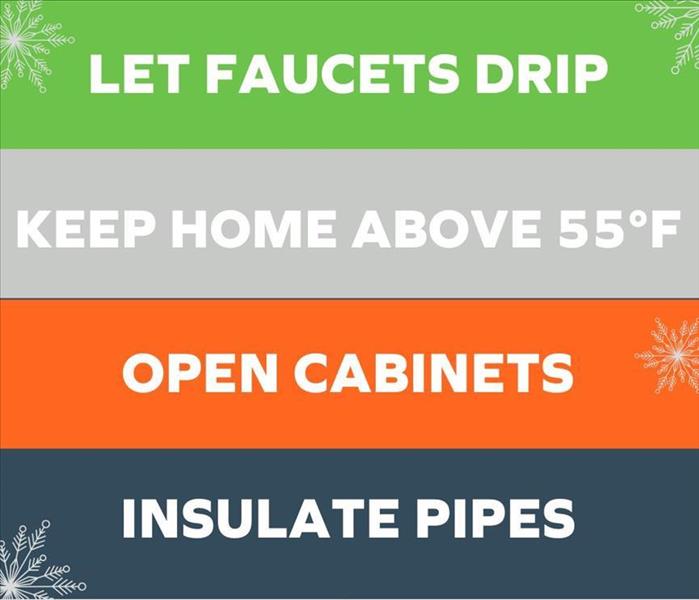Recent Posts
Understanding Ice Dams and How to Address Their Impact
1/23/2025 (Permalink)
As Central Pennsylvania grapples with sub-zero temperatures, homeowners face the heightened risk of ice dams. These pesky formations are not just a winter inconvenience; they can lead to significant property damage if left unchecked.
Here's everything you need to know about ice dams, their prevention, potential damage, and how SERVPRO Team Weaver can help.
What Are Ice Dams?
Ice dams form when snow on your roof melts, flows down, and refreezes near the eaves, where temperatures are colder. Over time, this ice buildup creates a barrier that prevents proper drainage, forcing water to seep under shingles and into your home.
How Do Ice Dams Form?
- Heat Escape: Warm air escapes from the attic, melting the snow on the roof.
- Cold Eaves: The melted snow freezes as it reaches the cooler edges of the roof.
- Blocked Drainage: This frozen barrier traps subsequent meltwater, which can then leak into your home.
Damage Ice Dams Can Cause
Ice dams can wreak havoc on your property, including:
- Water Damage: Leaks can penetrate walls, ceilings, and insulation, leading to water stains and mold growth.
- Structural Damage: Repeated freezing and thawing can compromise roofing materials and gutters.
- Decreased Energy Efficiency: Damaged insulation allows heat to escape, raising heating costs.
Preventing Ice Dams
Proactive measures are essential to prevent ice dams:
- Improve Insulation: Proper attic insulation minimizes heat escape.
- Ventilation: Ensure adequate attic ventilation to keep roof temperatures consistent.
- Snow Removal: Use a roof rake to remove snow buildup safely.
SERVPRO Team Weaver: Your Partner in Ice Dam Damage Restoration
If ice dams have already caused damage, SERVPRO Team Weaver is here to help. We specialize in restoring your home to preloss condition, offering:
- Water Damage Restoration: We address leaks and mitigate water damage with advanced equipment.
- Mold Remediation: Our team ensures your home is free from mold caused by trapped moisture.
- Emergency Services: With our “Faster to any size disaster” promise, we act quickly to minimize damage????.
Why Choose SERVPRO Team Weaver?
- 24/7 Availability: We’re always ready to respond to your emergencies.
- Skilled Professionals: Our highly trained team utilizes industry-leading techniques and technology.
- Comprehensive Solutions: From assessment to final restoration, we handle every step of the process.
- Commitment to Excellence: Our goal is to make it "Like it never even happened."
This winter, don’t let ice dams compromise your safety and comfort. Stay proactive with prevention, and trust SERVPRO Team Weaver to restore your home should damage occur.
Contact us today for expert guidance and prompt service.
Protect Yourself Against Water Damage By Avoiding Frozen Pipes This Winter
1/22/2025 (Permalink)
Cold weather can lead to significant damage from frozen pipes. Follow these tips to safeguard your home or business:
- Set thermostats to 55°F or higher to keep your pipes above freezing temperature.
- Drip cold water from the faucet farthest from the main water valve. Continuous water flow helps prevent freezing.
- Locate your main shut-off valve for emergencies and mark it for easy access.
- Insulate pipes in unheated areas like basements, crawl spaces, or garages.
- Open cabinets and vanities to allow warm air to circulate around exposed pipes.
- Drain and shut off outdoor spigots by closing interior valves, then leave the exterior spigot open. This helps any remaining water expand without causing pipe breaks.
- Prepare early for freezing temperatures by draining outdoor irrigation systems and sealing drafty areas around pipes.
Thawing Frozen Pipes
If you suspect your pipes have frozen, act quickly to prevent further damage:
- Confirm the issue: Ask a neighbor if they’re experiencing water loss; if not, your pipes are likely frozen.
- Turn off water at the main valve to avoid flooding when the ice thaws.
- Open faucets: Allow water to flow as ice melts, reducing pressure and speeding up thawing.
- Apply safe heat sources: Use a hair dryer or portable heater, but keep heat away from flammable materials. Avoid open flames, blow torches, or any method that could cause boiling or pipe damage.
- Inspect for leaks or cracks after thawing and turn the water back on slowly to check for damage.
In Case of Burst Pipes
- Turn off water immediately using your main shut-off valve.
- Call SERVPRO® to address water damage and ensure your property is restored "Like it never even happened®."
Protect Your Home in Bedford and Southern Blair County with Professional Dryer Vent Cleaning
10/16/2024 (Permalink)
 A dirty dryer vent is a fire hazard that could be lurking in your home.
A dirty dryer vent is a fire hazard that could be lurking in your home.
Fire cleanup in Bedford, Martinsburg, and throughout Southern Blair County is often caused by preventable issues like clogged dryer vents. Many house fires each year are linked to neglected dryer vent maintenance, leading to extensive damage and costly fire restoration. SERVPRO Team Weaver provides expert dryer vent cleaning services to help reduce the risk of fire and improve the efficiency of your dryer. Regular cleaning is a crucial step in safeguarding your home from fire hazards and avoiding expensive repairs.
How Clogged Dryer Vents Lead to Fires
When lint, dust, and other debris accumulate in dryer vents, it restricts airflow and causes the dryer to overheat. This creates a dangerous fire hazard, as lint is highly flammable. A single spark can quickly ignite a fire, requiring fire cleanup in Bedford, Martinsburg, and across Southern Blair County. According to the U.S. Fire Administration, failure to clean dryer vents is a leading cause of home dryer fires. Professional vent cleaning helps prevent this risk and keeps your home safe.
Why Professional Dryer Vent Cleaning is Essential
- Fire Prevention: Removing lint and debris from your dryer vent prevents overheating and significantly reduces the risk of a fire.
- Improved Dryer Efficiency: Clean vents allow your dryer to work more efficiently, reducing drying times and saving on energy bills.
- Longer Dryer Lifespan: A well-maintained dryer lasts longer, minimizing the need for costly repairs or replacements.
- Peace of Mind: SERVPRO Team Weaver uses specialized equipment to thoroughly clean your vent system, ensuring it's safe and free of fire hazards.
When to Schedule Dryer Vent Cleaning
To prevent fires in Southern Blair County, it’s recommended that you have your dryer vents professionally cleaned at least once a year. If you notice your dryer taking longer to dry clothes or getting hotter than usual, it’s a sign you need to schedule a cleaning sooner.
Don’t Delay – Act Now to Prevent Fires
Neglecting dryer vent cleaning can lead to severe consequences, including house fires and carbon monoxide poisoning in homes with gas dryers. The extra strain on your dryer can also lead to expensive repairs or even a full replacement. Instead of waiting for a disaster, take the simple preventative step of scheduling a cleaning.
At SERVPRO Team Weaver, we are committed to helping homeowners in Bedford, Martinsburg, and across Southern Blair County stay safe and avoid fire restoration needs. Schedule a professional dryer vent cleaning today to protect your home and family from fire hazards.
Contact SERVPRO Team Weaver for Dryer Vent Cleaning Today
If you haven’t had your dryer vent cleaned recently, now is the time to act. Contact SERVPRO Team Weaver for professional dryer vent cleaning services. Visit our website at [your website URL] or call us at [your phone number] to learn more and book your appointment today.
Avoiding Common Pitfalls: Mistakes to Steer Clear of When Making a Fire Claim
10/1/2024 (Permalink)
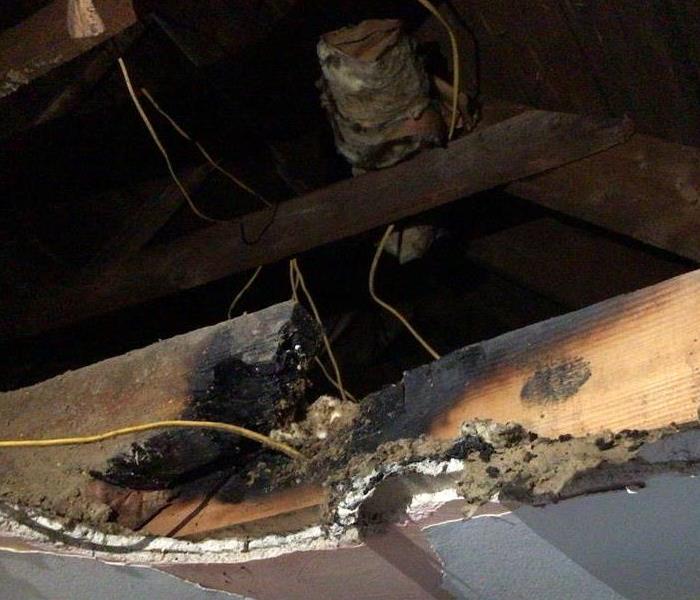 Faulty wiring in the attic was the source of a fire in Bedford County, PA
Faulty wiring in the attic was the source of a fire in Bedford County, PA
Experiencing a fire in your home or business is not just about devastating loss; it’s unfortunately also about navigating the tricky maze of insurance claims afterward. Making a fire claim can feel overwhelming, especially when you're already dealing with emotional and physical distress.
Understanding the fire claims process is vital to ensuring you get the compensation you deserve. It’s easy to overlook details when you’re preoccupied with cleanup and recovery, but these missteps can cost you time and money. The right knowledge and preparation will help you dodge common pitfalls often faced during these situations.
This article is here to guide you through the essential steps and common mistakes to avoid when making a fire claim. We'll cover everything from immediate damage cleanup to timely submissions so you can focus on what truly matters—getting your life back on track.
Understanding the Fire Claims Process
Fire damage can be devastating for homeowners and businesses alike. Understanding the claims process following such an event is crucial for a smooth restoration journey. When you experience fire damage, promptly notify your insurance company to initiate a claim. Your insurance provider will likely request a detailed list of damaged items.
A claims adjuster will be appointed to assess the extent of the damage. This step involves damage assessments, evaluating the effects of both the fire and the water damage from firefighting efforts. The adjuster will determine the coverage under your insurance policy and help navigate the necessary damage repairs.
During the process, it's important to keep all receipts and document any emergency repairs or debris removal undertaken to prevent additional damage. The insurance company will require these when evaluating your claim.
Finally, once your claim is approved, the funds will be disbursed, allowing you to begin comprehensive restoration services, which may include soot removal, water damage restoration, structural cleaning, and even mold removal. Open communication with your insurance company is key to resolving the claim and restoring your property to pre-disaster conditions.
Remember:
- Notify your insurance provider immediately.
- Compile a list of damaged items.
- The insurance adjuster assesses the damage.
- Prevent further damage and keep receipts.
- Open communication with your insurance company expedites the process.
- Having a company like SERVPRO of Southern Blair Bedford on your side helps make the process easier.
Taking Critical Steps While Waiting for Help
When faced with fire damage in Bedford County, it's vital to act promptly. While waiting for professional cleanup and restoration services, property owners can take some critical steps to mitigate further damage. Here's what you can do:
- Safety First: Make sure the property is structurally safe before re-entering.
- Ventilation: Open windows and doors if possible, to air out the property, reducing smoke and soot in the air.
- Utilities: Turn off water, gas, and electricity to prevent additional risks.
- Protect Valuables: If safe to do so, remove valuable items to secure them from potential water or structural damage.
- Documentation: Take photos and document all areas affected by damage for your insurance claim.
Waiting for help doesn't mean being passive. These steps protect your property and can ease the restoration process once professionals, skilled in soot and odor removal, structural cleaning, and more, arrive.
Remember to contact your insurance provider promptly as well to initiate the claims process. Stay safe and let the expert damage restoration teams do what they do best—bringing your home or commercial property back to pre-disaster condition.Documenting Your Damage Thoroughly
After the blaze has been doused and the immediate threats have passed, it's time to focus on what comes next. If you're standing amidst the charred remains of what used to be a part of your Bedford County home or business, know that proper documentation is your next best tool. Grab your camera or smartphone – it's time to get meticulous with your record-keeping.
Snap pictures from multiple angles of each room impacted by the fire. Don't forget to capture images of individual damaged items, the more detailed, the better. These visuals serve as evidence for your insurance company to assess the extent of the damage and decide on your compensation. Keep an inventory list as detailed as you can, jotting down item names, their conditions, and estimated value. Photos paired with a descriptive list form a comprehensive record that can significantly streamline the claims process.Remember, this documentation isn't just for filing an insurance claim. It's also invaluable when it comes to the actual clean-up and restoration because it gives the pros a heads-up on what kind of repairs or replacements are in order.
Avoiding Delays: Importance of Timely Claims Submission
Alright, let's get into it! After a fire has swept through, it can feel like the clock is working against you. But here's the deal—when it comes to working with your insurance company, speed is your friend. Submitting your claim ASAP is critical. It’s not just about ticking off a task on your checklist; it’s about setting the restoration process in motion and getting back to normal, pronto.
Your SERVPRO restoration team isn’t just a lifeline, they're like the pit crew in your post-disaster race. Late claims can hit a speed bump with more scrutiny or, even worse, get denied. Plus, the faster you get that claim in, the quicker the debris removal and structural cleaning can begin. Don’t let the stress simmer, reach out to your insurance company and SERVPRO of Southern Blair Bedford quickly and keep those damage repairs on track.
Securing the Property from Further Damage
Now, onto making sure things don’t go from bad to are-you-kidding-me. It's about more than just locking the doors; securing your property means shielding it from the elements and unwanted guests—both human and critter. Here’s your checklist: cover those breaches, from gaping holes to busted windows, and always keep one step ahead of moisture because, trust me, water damage is not an extra you want.
For your peace of mind and to prevent that additional damage, some pros in Bedford County offer emergency response options that have your back 24/7. Think of it like putting up an invisible shield until the full water damage restoration services and damage restoration services can save the day. SERVPRO Team Weaver offers immediate board up services to secure your property until restoration has begun.
Documenting Everything: Photos and Notes
Remember that science class where they made you record every single detail of those experiments? Well, it's showtime for those skills. Snap pictures or videos of the damage from all angles—like a paparazzi at a movie premiere. Then grab a notebook or your phone and jot down notes. The more you document, the better the narrative you present to your insurance company.
Date
Description of Damage
Room/Area
Note Taken
MM/DD/YYYY
Photo of charred kitchen cabinets and melted appliances
Kitchen
Yes
MM/DD/YYYY
Video of water damage on living room ceiling
Living Room
Yes
This table isn't just for your memory's sake; it's a solid proof for insurance claims. Plus, when the restoration experts jump into action, it helps them size up the disaster and tailor the cleanup game.
When you work with SERVPRO of Southern Blair Bedford, they do most of the documentation work for you. In addition to documenting the large damages, they will photograph all of the contents of your home or business so you can make a thorough insurance claim.
Common Mistakes to Avoid in Fire Claims
When it comes to navigating the aftermath of a fire in Bedford County, you want to be sure that you’re on top of your game, especially dealing with insurance claims. We’ve all heard the stories of some poor soul who got shortchanged during their fire claim because they missed a few key steps. So, let's dive into the common slip-ups you'll want to dodge to ensure you're getting the most out of your insurance company after a fire has left its mark on your property.
Overlooking Secondary Damage Types
Now let’s chat about secondary damage. Post-fire, your place isn’t just dealing with the aftermath of the flames. There’s a whole bunch of other invisible hiccups that can creep up on you. I’m talking water damage from firefighting efforts, smoke damage lingering in every nook and cranny, and let's not forget soot that makes itself at home pretty much everywhere. Often, folks are so focused on the char and burn that they forget these sneaky culprits. So, when you're making your list of woes for the insurance provider, don't let these additional damage types fall through the cracks. Keep an eye out:
- Water Damage: Peep for warped wood, stained walls, or mold sprouting up.
- Smoke Damage: Look out for discoloration, smoky smells, or damaged electronics.
- Soot Damage: It's messy, it's acidic, and it can ruin just about anything it touches.
Ignoring Policy Limitations and Exclusions
Alright, here's the deal with insurance policies – they can be as complex as that one puzzle you got for Christmas and never finished. Each policy has its own set of what’s covered (limitation) and what's not (exclusion), and you better believe you need to understand these sections like the back of your hand. Maybe you've got a cap on how much they'll dish out for structural cleaning or debris removal, or perhaps damage from a certain cause isn't covered at all. Knowing your policy inside and out can save you from a world of financial hurt and also help streamline the damage restoration services that you’ll enlist. So give it a thorough read, maybe even phone a friend (or a professional) to decode the jargon for you.
Failing to Keep Receipts and Documentation
Now we reach the pen and paper part – or the 21st-century equivalent with your phone and cloud backups. Every receipt post-fire – be it for water damage restoration services or temporary lodging – needs to be kept tighter than your favorite pair of jeans after the holidays. This includes receipts for air duct cleaning, soot removal, odor removal, you name it. And it’s not just about stashing them away; it's about organizing them in a way that would make Marie Kondo proud. These little slips of paper are the proof you need that the money you're claiming was genuinely invested in your property's restoration process. Don't let them be an afterthought, or it could cost you big time when it comes to reimbursement from the insurance company.
In summary, getting through a fire claim without additional headaches means being mindful of the full scope of damage, understanding your policy, and holding onto every piece of financial proof like it's a golden ticket. Whether your property in Bedford County is residential or commercial, these tips can save you a lot of hassle and ensure you're properly compensated. So stay sharp, and don't let these common mistakes burn a hole in your recovery process.
Conclusion: Best Practices for Successful Claims
When the last flame of a fire is extinguished in Bedford County, the real work begins. Tackling fire damage cleanup and restoration is daunting, but adopting the best practices ensures successful claims and makes the process smoother.
Hire Professionals: Engage a professional fire mitigation team like SERVPRO of Southern Blair Bedford. They're not just experts in damage restoration services and debris removal; they're adept at handling the specifics of both water damage restoration services and comprehensive fire damage restoration.
Insurance Collaboration: SERVPRO works closely with your insurance provider, ensuring that every step of the restoration process aligns with your insurance policies. This mitigates the risk of unexpected costs and helps streamline the insurance claim.
Damage Assessment: A thorough damage assessment paves the way for precise repairs. Whether it's damage from firefighting efforts, smoke damage, or structural cleaning, a professional team ensures all areas of concern are addressed.
Immediate Action: An emergency response is vital in preventing additional damage. The sooner professionals can begin soot removal, odor removal, and potentially necessary mold removal, the better the outcome.
By entrusting the work to SERVPRO of Southern Blair Bedford County, you leverage their expertise in dealing with severe to extensive damage, ensuring a seamless transition from chaos to restoration. Whether it's a residential aftermath or commercial properties in distress, no Size Disaster is too daunting for them to handle.
Call SERVPRO Team Weaver today at (814) 624-9083 today!
Securing Your Financial Future: Planning for Water Damage Preparedness in Pennsylvania
10/8/2023 (Permalink)
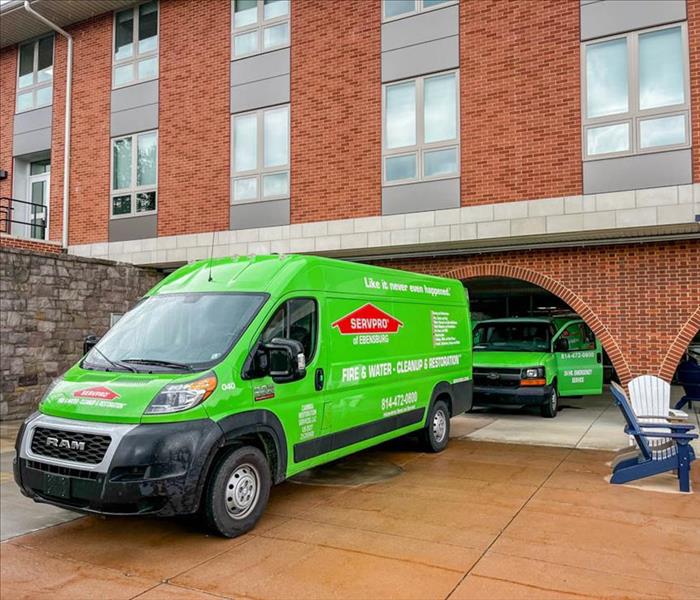 Water damage is a common and often costly issue for homeowners and businesses.
Water damage is a common and often costly issue for homeowners and businesses.
Water damage is a common and often costly issue for homeowners and businesses. Preparing for potential water damage and having a financial plan in place can make a significant difference in how well you recover from unexpected events. In this blog, we'll explore the importance of financial planning for water damage preparedness in Pennsylvania, providing insights and tips to help you safeguard your financial future.
1. Understand Your Insurance Coverage
One of the first steps in financial planning for water damage preparedness is to review your insurance policies. Most standard homeowner's insurance policies cover certain types of water damage, such as burst pipes or accidental leaks. However, they may not cover flooding from natural disasters. Consider adding flood insurance if you live in a flood-prone area, as this can be a financial lifesaver.
2. Build an Emergency Fund
Having an emergency fund can help you cover immediate expenses in the event of water damage. Aim to save at least three to six months' worth of living expenses in a readily accessible account. This fund can cover deductibles, temporary accommodation costs, and emergency repairs.
3. Regular Maintenance
Investing in regular home maintenance can prevent water damage and save you money in the long run. Inspect and maintain your roof, plumbing systems, gutters, and foundation to catch potential issues before they become costly emergencies.
4. Create a Water Damage Budget
Consider creating a separate budget or sinking fund specifically for potential water damage. Set aside a portion of your monthly income to cover maintenance, repairs, and unexpected incidents. Having a designated fund can prevent financial stress when water damage occurs.
5. Document Your Belongings
Maintain an inventory of your belongings, including photographs and receipts. This documentation can be invaluable when filing insurance claims after water damage. Store this information in a secure, easily accessible location.
6. Consult with Restoration Experts
Establish a relationship with a reputable restoration company like SERVPRO® of Southern Blair and Bedford County. They can provide you with estimates for potential restoration costs and help you plan for unexpected emergencies. Having a professional on your side can streamline the recovery process.
Financial planning for water damage preparedness in Pennsylvania is a prudent step toward safeguarding your financial future. By understanding your insurance coverage, building an emergency fund, and investing in preventative maintenance, you can mitigate the financial impact of water damage incidents. Remember that SERVPRO® of Southern Blair and Bedford County is here to assist Pennsylvania residents with professional cleanup and restoration services, should the need arise. We are committed to helping you recover from water damage and protect your financial well-being.
The Role of Snow Removal Services and Storm Cleanup
9/5/2023 (Permalink)
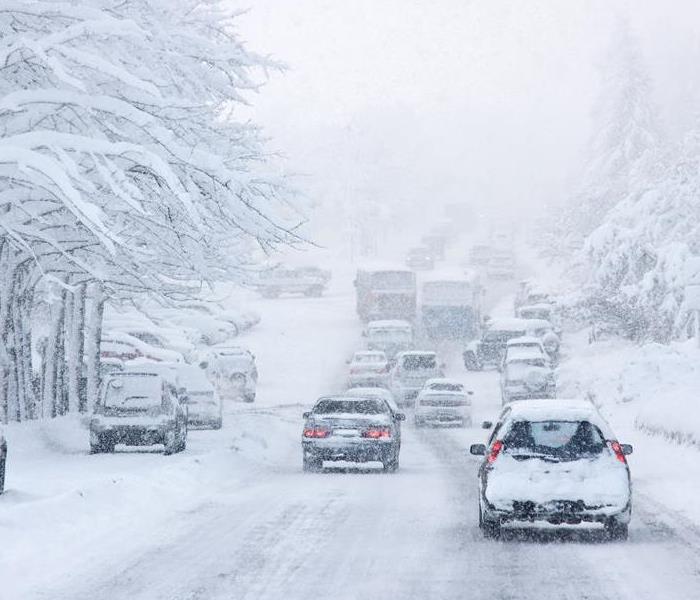 Snow removal is a vital service to ensure roads are safe after a winter storm.
Snow removal is a vital service to ensure roads are safe after a winter storm.
The Northeast is no stranger to severe winter storms and heavy snowfall. These winter weather events can create significant challenges for homeowners and businesses alike. That's where professional snow removal services play a crucial role in the aftermath of a Northeast storm. In this blog post, we will discuss the importance of snow removal services in Northeast storm cleanup and how they help restore normalcy after winter weather events.
Clearing Roads and Pathways
One of the primary roles of snow removal services after a Northeast storm is to clear roads and pathways. Accumulated snow can make roads impassable, leading to traffic congestion and potential accidents. Professional snow removal services have the equipment and expertise to quickly and efficiently clear the snow, allowing for safe travel and enabling emergency services to respond effectively.
Preventing Accidents and Injuries
Snow and ice make surfaces slippery and increase the risk of accidents and injuries. Snow removal services play a crucial role in minimizing these risks by clearing parking lots, sidewalks, and driveways. By removing snow and ice, they create safe walking surfaces, reducing the chances of slips, falls, and other accidents. This is especially important for businesses and municipalities, as they have a responsibility to maintain safe conditions for employees, residents, and visitors.
Preventing Structural Damage
Heavy snowfall can put a significant strain on roofs, especially when it's wet and compacted. Snow removal services help prevent structural damage to buildings by clearing snow from rooftops. By removing excess snow, they relieve the weight on roofs, reducing the risk of collapse and potential damage to the building and its contents. This is particularly important for commercial properties, as roof collapse can lead to business interruption, financial losses, and safety hazards.
Restoring Normalcy
Winter storms can disrupt daily life and disrupt normal routines. Snow removal services play a crucial role in restoring normalcy after a Northeast storm by clearing snow and ice from residential and commercial properties. They enable businesses to resume operations and ensure that homeowners can navigate their properties safely. By quickly and efficiently removing snow, these services help communities recover and get back on track sooner.
Expertise and Equipment
Professional snow removal services have the necessary expertise and equipment to handle even the most challenging winter storms. They have trained personnel who are experienced in snow removal techniques, ensuring that the job is done efficiently and effectively. Additionally, they have access to specialized equipment, such as snowplows, snow blowers, and ice melters, which allows them to tackle large snow accumulations and icy conditions with ease.
Snow removal services play a vital role in the cleanup efforts following Northeast winter storms. They clear roads and pathways, prevent accidents and injuries, prevent structural damage, and help restore normalcy to affected areas. Their expertise and specialized equipment enable them to handle even the most challenging snow and ice conditions. By relying on professional snow removal services, communities and individuals can efficiently and safely recover from winter weather events and continue with their daily lives.
Unveiling the Lingering Menace of Smoke Damage
8/15/2023 (Permalink)
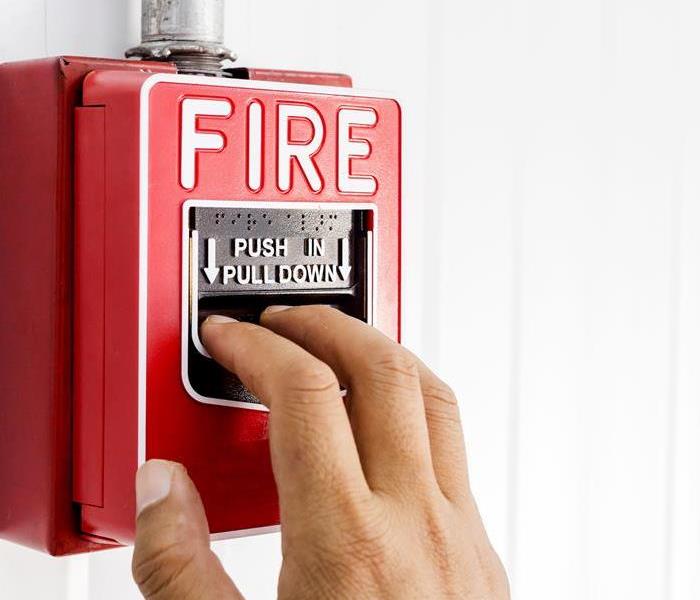 Smoke and fire damage can leave unfortunate structural integrity of your building.
Smoke and fire damage can leave unfortunate structural integrity of your building.
A fire can be a devastating event, causing immense destruction and leaving behind a trail of chaos. While the flames may be the most obvious culprit, there is another silent intruder that can wreak havoc long after the fire has been extinguished: smoke. Smoke damage is often underestimated, yet it can pose serious risks to both the structural integrity and the health of your building's occupants. In this article, we'll explore the hidden dangers of smoke damage and provide insights into its mitigation and restoration.
The Scope of Smoke Damage
When a fire occurs, smoke particles and chemical substances are released into the air. Smoke can quickly infiltrate every nook and cranny of a building, leaving behind a residue that can cause significant damage. The extent of smoke damage depends on various factors, including the size of the fire, the materials burned, and the duration of exposure.
Structural Impacts
- Discoloration and Staining: Smoke particles can settle on surfaces, causing discoloration and staining of walls, ceilings, furniture, and other belongings. Over time, these stains can become more stubborn and difficult to remove.
- Odor: The pungent odor of smoke can linger long after a fire. It can permeate porous materials such as carpets, curtains, upholstery, and even building materials like drywall. This persistent smell can be unpleasant and hard to eliminate without proper remediation.
- Corrosion: Smoke contains corrosive substances that can damage metal surfaces, electrical systems, and appliances. If left untreated, this corrosion can compromise the functionality and safety of these components.
Mitigation and Restoration
After a fire, it's crucial to engage a professional restoration company experienced in smoke damage remediation. They will conduct a thorough assessment to identify the extent of the damage and develop an appropriate plan of action. Professional technicians will employ specialized techniques and equipment to clean surfaces, remove soot and residue, and eliminate odors. This may include dry cleaning, wet cleaning, air scrubbing, and the use of ozone generators or thermal fogging.
Smoke can infiltrate the building's HVAC system, spreading contaminants throughout the structure. A thorough inspection and cleaning of the system are necessary to ensure the removal of any smoke particles and to prevent further circulation of pollutants. In severe cases, damaged materials, such as insulation, drywall, or carpets, may need to be removed and replaced. This step is crucial to eliminate any hidden smoke residues and restore the integrity of the building.
Prevention and Preparedness
Ensure that your building is equipped with functioning smoke detectors on every floor and in each room. Regularly test and maintain these devices to guarantee their effectiveness. Create an emergency evacuation plan and educate occupants about fire safety procedures. Conduct regular drills to ensure everyone is familiar with the evacuation routes and knows how to respond in case of a fire. Implement fire-safe practices such as proper storage of flammable materials, regular maintenance of electrical systems, and safe usage of heating appliances.
Smoke damage is a formidable foe that can silently compromise the structural integrity of your building. Remember, when it comes to smoke damage, swift action and expert assistance are key to restoring your building to its pre-fire condition and ensuring a safe environment for all.
Accidental Activation: What to Do If Fire Sprinklers Go Off Unexpectedly
7/27/2023 (Permalink)
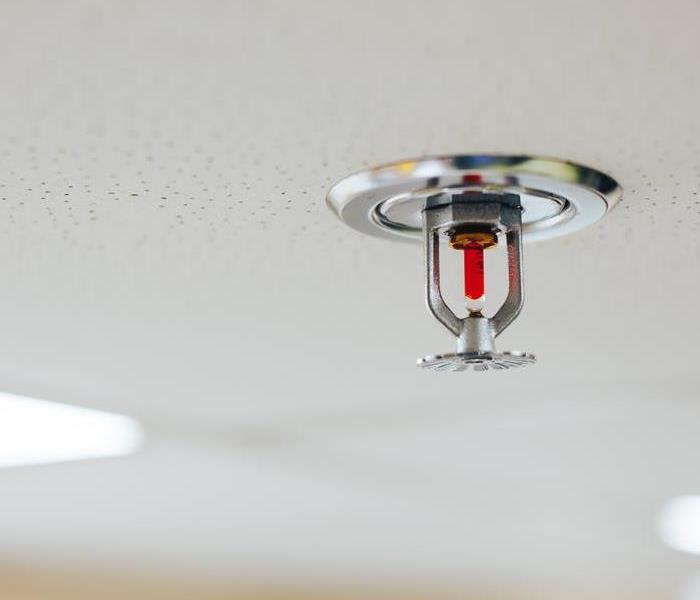 Accidental activation of a fire sprinkler can leave your building with significant water damage.
Accidental activation of a fire sprinkler can leave your building with significant water damage.
Fire sprinkler systems are designed to protect lives and property by quickly responding to fire emergencies. However, there are instances when fire sprinklers may be triggered accidentally, causing water damage and potential disruption. Understanding how to respond calmly and effectively in such situations can help minimize damage and ensure a swift resolution. In this blog post, we'll discuss the necessary steps to take if fire sprinklers go off accidentally.
Stay Calm and Assess the Situation
The first and most crucial step is to remain calm. Panicking can hinder your ability to make rational decisions. Take a moment to assess the situation and determine the cause of the accidental activation. Look for any signs of fire or smoke, as well as potential triggers such as physical impact, temperature fluctuations, or a malfunctioning sprinkler head.
Locating the main water shut-off valve is essential to stop the flow of water and minimize further damage. Familiarize yourself with the building's fire protection system and identify the valve's location beforehand, if possible. Typically, the valve is found near the sprinkler riser or in a utility room. Shutting off the water supply should halt the flow of water from the sprinklers.
Call Emergency Services
If there is any indication of a fire, immediately call the emergency services (fire department) and inform them about the situation. Even if there is no fire, it's essential to report the accidental activation to ensure proper documentation and assistance, if needed. The fire department can provide guidance and assess the situation upon their arrival.
Inform the property manager or building owner about the accidental activation of the fire sprinklers. They should be notified promptly to initiate necessary actions, such as coordinating repairs, assessing water damage, and communicating with relevant parties, such as insurance companies.
Document the Incident
Take photos and videos of the affected areas, documenting the extent of water damage caused by the accidental sprinkler activation. This documentation will be valuable for insurance claims and any subsequent investigations. Make notes regarding the time and date of the incident, the circumstances surrounding the activation, and any visible damages.
Once the water flow has been stopped, focus on mitigating water damage as much as possible. Use mops, towels, or a wet-dry vacuum to remove standing water. Place buckets or containers under any active leaks to collect water and prevent further damage to furniture or electronics. Open windows and doors to facilitate air circulation and aid in the drying process.
Seek Professional Restoration Services
Depending on the severity of the water damage, it may be necessary to engage professional restoration services. Water damage restoration experts have the knowledge, equipment, and experience to properly assess and address the situation. They can help with water extraction, drying, dehumidification, and restoring affected areas to their pre-incident condition.
Contact your insurance provider to report the incident and initiate the claims process. Provide them with the necessary documentation, including photos, videos, and any other relevant information. Follow their instructions and keep track of all communication for reference.
Schedule Sprinkler System Inspection and Repair
Arrange for a professional inspection of the fire sprinkler system to determine the cause of the accidental activation and ensure its proper functioning. Engage a licensed fire protection company to assess and repair any damaged sprinkler heads or components. Regular maintenance and inspections are crucial for the continued reliability and effectiveness of the fire sprinkler system.
Accidental activation of fire sprinklers can serve as a learning experience. Evaluate the incident and consider implementing preventive measures to minimize the chances of future accidents. This may involve reviewing protocols for activities that could potentially trigger the sprinklers, such as renovations or high-temperature processes.
Dealing with accidental activation of fire sprinklers requires prompt action, clear-headedness, and effective communication. By following the steps outlined above, you can mitigate water damage, ensure proper documentation, and initiate the necessary repairs. Remember, it's crucial to stay calm, contact emergency services, shut off the water supply, and communicate with the relevant parties. With the right approach, you can efficiently handle the situation and restore normalcy while maintaining the integrity of your fire sprinkler system.
Preparing for the Storm: Developing a Business Continuity Plan
6/5/2023 (Permalink)
Preparing for a storm is essential for any company. Storms can cause extensive damage to homes and businesses, making it crucial to have a business continuity plan (BCP) in place. By having a BCP, your company can ensure that critical services continue to operate during and after a storm, minimizing potential financial losses. In this blog post, we will discuss the steps involved in developing a BCP to prepare for a storm.
Identify key personnel and their roles
The first step in developing a BCP is to identify key personnel and their roles. This includes the people who will be responsible for implementing the plan during and after the storm. For a disaster restoration company, key personnel might include the operations manager, project managers, technicians, and customer service representatives. Each person should have a clear understanding of their role and responsibilities during a storm, such as assessing damage, responding to emergency calls, and coordinating with insurance companies.
Identify critical business functions
Next, identify your company's critical business functions. These are the services that are essential to your company's operations and revenue generation. For a disaster restoration company, critical business functions might include emergency response, damage assessment, water extraction, mold remediation, and reconstruction. It is essential to prioritize these functions and develop a plan to ensure they can continue during and after a storm.
Assess potential risks and impact
Before developing a plan, it is crucial to assess the potential risks and impact of a storm. This includes identifying the types of storms that could affect your area, the likelihood of them occurring, and their potential impact on your business. You should also assess the impact of a storm on your employees, customers, and suppliers, and develop a plan to address these impacts.
Develop a communication plan
Effective communication is critical during a storm. Develop a communication plan that includes how you will communicate with employees, customers, suppliers, and other stakeholders during and after a storm. This should include multiple methods of communication, such as phone, email, text message, and social media.
Develop a recovery plan
Finally, develop a recovery plan to ensure that your company can quickly return to normal operations after a storm. This should include procedures for assessing damage, prioritizing repairs, and restoring critical business functions. It is also essential to communicate with customers and suppliers about your recovery efforts and any potential delays.
In conclusion, developing a BCP is crucial for companies to prepare for a storm. By identifying key personnel and their roles, critical business functions, potential risks, and developing a communication and recovery plan, your company can continue to operate and provide critical services during and after a storm.
Hidden Threat: Mold in Air Ducts - What You Need to Know and How to Deal with It
5/23/2023 (Permalink)
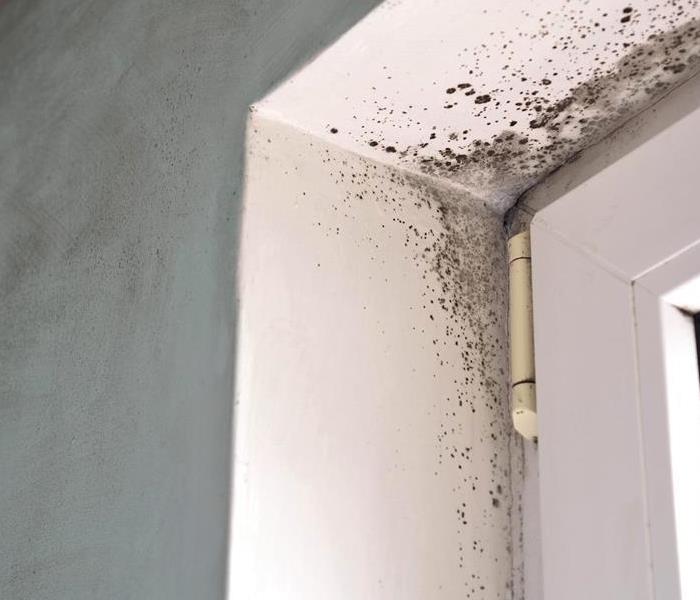 If you suspect mold in your home, its essential to call a professional immediately.
If you suspect mold in your home, its essential to call a professional immediately.
As a homeowner, you want to ensure that your indoor air is clean and safe for you and your family to breathe. However, one potential threat that often goes unnoticed is mold in air ducts. Mold growth in air ducts can be harmful to your health and may lead to poor indoor air quality. In this blog, we will explore the signs of mold in air ducts, the risks associated with it, and what you can do to address this issue.
Signs of Mold in Air Ducts
Air ducts are hidden from view, making it challenging to detect mold growth. However, there are several signs that may indicate the presence of mold in your air ducts.
If you notice a persistent musty or moldy smell coming from your air vents, it could be an indication of mold growth in the air ducts. Mold produces volatile organic compounds (VOCs) that can create an unpleasant odor.
Visible Mold Growth
In some cases, you may be able to see visible mold growth around the air vents or inside the air ducts. Mold can appear as fuzzy patches, discoloration, or black spots. If your home has experienced water damage or has high humidity levels, it can create favorable conditions for mold growth in air ducts. Moisture from leaks, condensation, or flooding can promote mold growth.
Risks of Mold in Air Ducts
Mold spores released from air ducts can circulate in the air and negatively impact indoor air quality. Breathing in mold spores can trigger allergies, respiratory issues, and other health problems, especially for those with allergies, asthma, or weakened immune systems.
Air ducts are part of the HVAC system, which means that mold growth in air ducts can spread to other areas of your home through the air circulation. This can lead to widespread mold contamination and make it more challenging to remediate.
Damage to HVAC System
Mold can also cause damage to your HVAC system, including the air ducts, vents, and coils. Mold can clog the air ducts, reduce airflow, and decrease the efficiency of your HVAC system, leading to higher energy bills and potential costly repairs.
Structural Damage
If mold growth in air ducts is left unaddressed for an extended period, it can cause structural damage to your home. Mold can deteriorate the ductwork, insulation, and other building materials, leading to costly repairs and renovations.
What to Do If You Suspect Mold in Air Ducts
If you suspect mold in your air ducts, it's crucial to take prompt action to address the issue. Here are some steps you can take. It's best to consult with a professional mold remediation service that has experience in handling mold in air ducts. They can conduct a thorough inspection of your HVAC system, identify the extent of mold growth, and provide appropriate remediation measures.
Ensure proper ventilation in your home can help reduce moisture buildup and inhibit mold growth in air ducts. Use exhaust fans in bathrooms and kitchens, and consider installing a dehumidifier to maintain optimal humidity levels. Also, fix any leaks or water damage promptly to prevent mold growth.
Clean and Seal Ducts
Professional duct cleaning can help remove accumulated dust, debris, and mold spores from the air ducts. Once cleaned, consider sealing the air ducts to prevent further mold growth.
If you suspect mold in your air ducts, it's essential to take swift action and consult with a professional mold remediation service. Proper inspection, cleaning, sealing, and maintenance of your HVAC system can help prevent the spread of mold and ensure clean and healthy indoor air. By being vigilant and proactive, you can safeguard your home and loved ones from the potential risks of mold in air ducts.




 24/7 Emergency Service
24/7 Emergency Service
